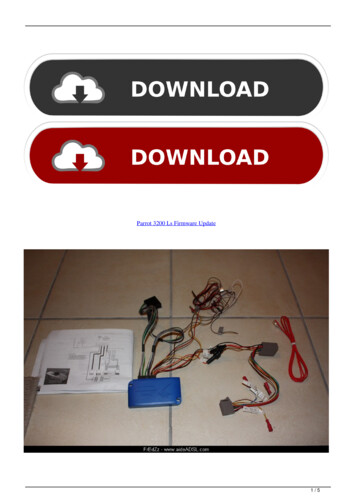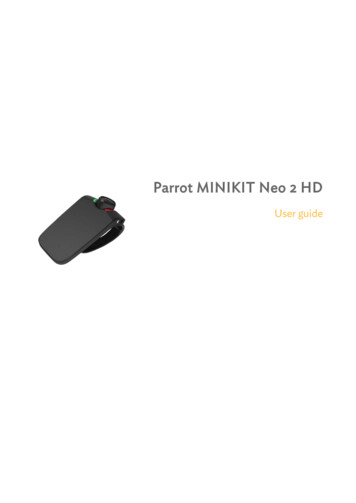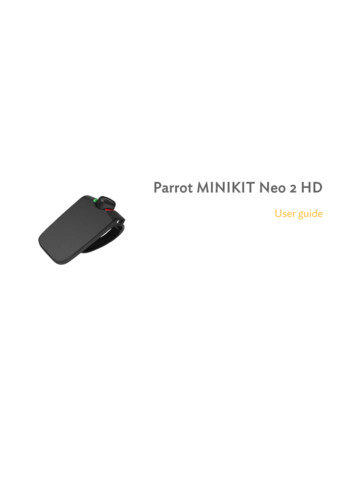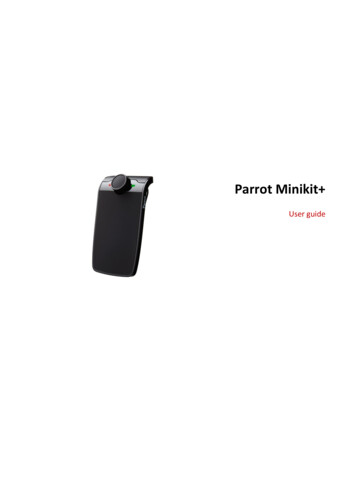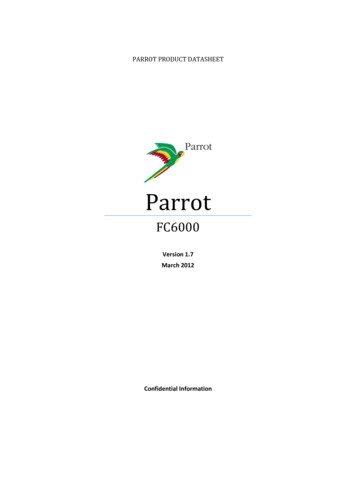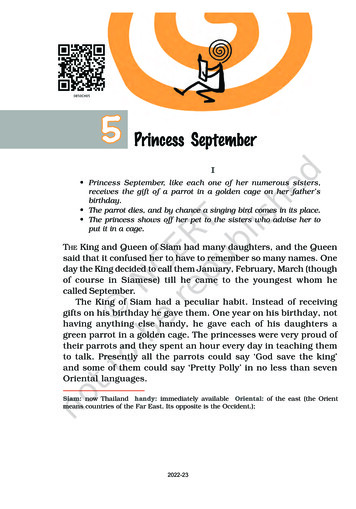
Transcription
Parrot
ParrotAbout the TutorialParrot is a virtual machine designed to efficiently compile and execute bytecode forinterpreted languages.Parrot is going to change the way you see PERL!AudienceThis tutorial has been designed for users who are willing to learn Microsoft PowerPoint insimple steps and they do not have much knowledge about computer usage and Microsoftapplications. This tutorial will give you enough understanding on MS PowerPoint fromwhere you can take yourself at higher level of expertise.PrerequisitesBefore proceeding with this tutorial, you should have a basic understanding of computerperipherals like mouse, keyboard, monitor, screen etc. and their basic operations.Copyright & Disclaimer Copyright 2014 by Tutorials Point (I) Pvt. Ltd.All the content and graphics published in this e-book are the property of Tutorials Point(I) Pvt. Ltd. The user of this e-book is prohibited to reuse, retain, copy, distribute orrepublish any contents or a part of contents of this e-book in any manner without writtenconsent of the publisher.We strive to update the contents of our website and tutorials as timely and as preciselyas possible, however, the contents may contain inaccuracies or errors. Tutorials Point (I)Pvt. Ltd. provides no guarantee regarding the accuracy, timeliness or completeness ofour website or its contents including this tutorial. If you discover any errors on ourwebsite or in this tutorial, please notify us at contact@tutorialspoint.comi
ParrotTable of ContentsAbout the Tutorial.iAudience .iPrerequisites .iCopyright & Disclaimer.iTable of Contents .ii1.PARROT OVERVIEW .12.PARROT INSTALLATION.23.PARROT INSTRUCTIONS FORMAT .3The Instruction Set .34.PARROT GARBAGE COLLECTION .45.PARROT DATATYPES .5What are PMCs?.56.PARROT REGISTERS.67.PARROT OPERATIONS.78.PARROT BRANCHES .8Parrot Operator.99.PARROT PROGRAMMING EXAMPLES.10Classic Hello world! .10Using Registers.10Summing Squares.11Fibonacci Numbers.13Recursively computing factorial .14ii
ParrotCompiling to PBC.16PIR vs. PASM .1610. PARROT USEFUL RESOURCES.18iii
Parrot1. Parrot OverviewWhen we feed our program into conventional Perl, it is first compiled into an internalrepresentation, or bytecode; this bytecode is then fed into almost separate subsysteminside Perl to be interpreted. So, there are two distinct phases of Perl’s operation: Compilation to bytecode and Interpretation of bytecode.This is not unique to Perl. Other languages following this design include - Python, Ruby,Tcl and even Java.We also know that there is a Java Virtual Machine (JVM) which is a platform independentexecution environment that converts Java bytecode into machine language and executesit. If you understand this concept then you will understand Parrot.Parrot is a virtual machine designed to efficiently compile and execute bytecode forinterpreted languages. Parrot is the target for the final Perl 6 compiler, and is used as abackend for Pugs, as well as variety of other languages like Tcl, Ruby, Python etc.Parrot has been written using most popular language "C".1
Parrot2. Parrot InstallationBefore we start, let’s download one latest copy of Parrot and install it on our machine.Parrot download link is available in Parrot CVS Snapshot. Download the latest version ofParrot and to install it follow the following steps: Unzip and untar the downloaded file. Make sure you already have Perl 5 installed on your machine. Now do the following:% cd parrot% perl Configure.plParrot ConfigureCopyright (C) 2001 Yet Another SocietySince you're running this script, you obviously havePerl 5 -- I'll be pulling some defaults from its configuration. You'll then be asked a series of questions about your local configuration; you canalmost always hit return/enter for each one. Finally, you'll be told to type - make test prog, and Parrot will successfully buildthe test interpreter. Now you should run some tests; so type ‘make test’ and you should see areadout like the following:perl t/harnesst/op/basic.ok,1/2 skipped:label constants unimplemented inassemblert/op/string.ok, 1/4 skipped:I'm unable to write it!All tests successful, 2 subtests skipped.Files 2, Tests 6,.By the time you read this, there could be more tests, and some of those which skippedmight not skip, but make sure that none of them should fail!Once you have a parrot executable installed, you can check out the various types ofexamples given in Parrot ‘Examples’ section. Also you can check out the examplesdirectory in the parrot repository.2
Parrot3. Parrot Instructions FormatParrot can currently accept instructions to execute in four forms. PIR (ParrotIntermediate Representation) is designed to be written by people and generated bycompilers. It hides away some low-level details, such as the way parameters are passedto functions.PASM (Parrot Assembly) is a level below PIR - it is still human readable/writable and canbe generated by a compiler, but the author has to take care of details such as callingconventions and register allocation. PAST (Parrot Abstract Syntax Tree) enables Parrot toaccept an abstract syntax tree style input - useful for those, writing compilers.All of the above forms of input are automatically converted inside Parrot to PBC (ParrotBytecode). This is much like machine code, but understood by the Parrot interpreter.It is not intended to be human-readable or human-writable, but unlike the other formsexecution can start immediately without the need for an assembly phase. Parrotbytecode is platform independent.The Instruction SetThe Parrot instruction set includes arithmetic and logical operators, compare andbranch/jump (for implementing loops, if.then constructs, etc.), finding and storingglobal and lexical variables, working with classes and objects, calling subroutines andmethods along with their parameters, I/O, threads and more.3
Parrot4. Parrot Garbage CollectionLike Java Virtual Machine, Parrot also keep you free from worrying about memory deallocation. Parrot provides garbage collection. Parrot programs do not need to free memory explicitly. Allocated memory will be freed when it is no longer in use i.e. no longerreferenced. Parrot Garbage Collector runs periodically to take care of unwanted memory.4
ParrotEnd of ebook previewIf you liked what you saw Buy it from our store @ https://store.tutorialspoint.com5
We also know that there is a Java Virtual Machine (JVM) which is a platform independent execution environment that converts Java bytecode into machine language and executes it. If you understand this concept then you will understand Parrot. Parrot is a virtual machine designed to efficiently compile and execute bytecode for
